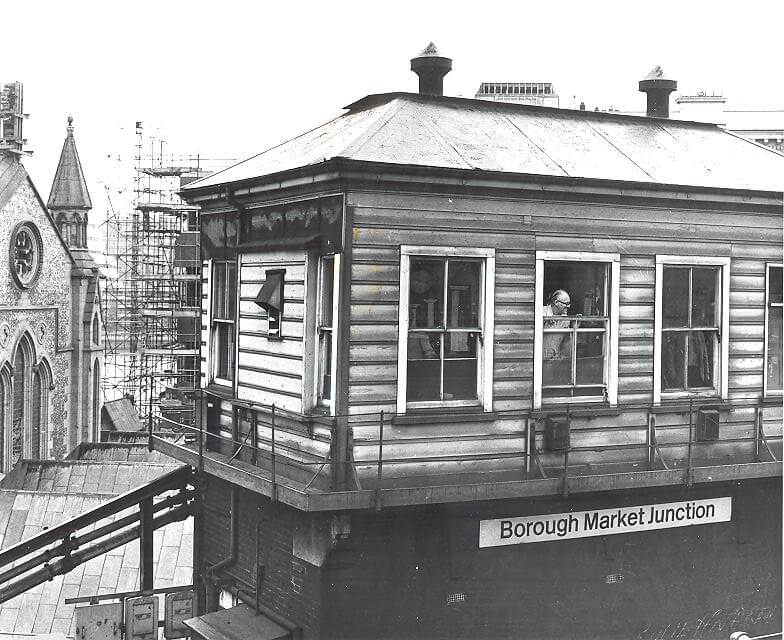The journey from London’s Borough Market to York typically takes about two and a half hours.
For what was once Britain’s busiest signal box, it will have taken more than 40 years to reach its final destination.
For over 80 years, the small Victorian structure sat upon a brick tower above the tracks and guided trains through Borough Market Junction, where the lines from London Bridge, Cannon Street and Charing Cross converge.
Traffic through the junction reached 1,000 trains a day, according to the National Railway Museum, often requiring two signallers to operate its 35 levers.
Space was tight – the box measures about 24 square metres – and work inside it tense; a signaller once said staff only cleared the signals when they could see the whites of the drivers’ eyes.
Preserving history
Built in 1895 to a standard South Eastern Railway (SER) design, Borough Market Junction signal box is one of only eight surviving SER-designed signal boxes.
It closed in 1976 when a new power signal box at London Bridge replaced it. Ever since, its home has been the National Railway Museum in York where its neighbours have included the Mallard, a working replica of Robert Stephenson’s Rocket locomotive, and the Flying Scotsman.
At the museum, historians have worked hard to restore the signal box for future generations. Network Rail recently donated original bricks from the box’s foundations in London as part of the restoration’s latest phase – an approximately £40,000 project to move it indoors, build a new base and provide access for visitors. Once completed, the box will once again sit at its original height.
Network Rail’s donation is the latest example of our commitment to conserving railway history – our work includes partnering with railway heritage organisations to document the operation and way of life associated with signal boxes.
Meanwhile, teaching our young engineers about the origins of the railway is part of our culture. In October, some of our graduates visited Severn Bridge Junction signal box – the largest working mechanical signal box in the world – to see how vital practices have evolved over the decades.
Andrew McLean, assistant director and head curator at the National Railway Museum, said: “[Borough Market Junction signal box] has been displayed outside for a number of years. Previously, we have replaced rotting woodwork, painted it and cleaned up the interior, which is otherwise largely untouched from when it was an operational box.
“The bricks recently presented to the museum from the remnants of the base will become part of the new base once the box is moved into the museum’s Great Hall. These will provide a strong visual link between the two severed parts of the historic box and help to symbolically reunite the box and its base, the full removal of which is impractical and costly – it is also incomplete.”
The project forms part of a broader £50m redevelopment at the museum. Andrew said: “As well as being a striking visual symbol, the box will help tell the important story of railway signalling, focussing not just on the technological aspects but the human stories too.”
Click on the gallery to see Network Rail graduates learning about signalling history at Shrewsbury’s Severn Bridge Junction
The epicentre of signalling
Borough Market Junction signal box isn’t just significant due to the pace of activity inside it; the junction itself is closely associated with the development of modern signalling practices, according to a report by the museum.
It said: “The early 19th century railway network relied on hand signalling to control train movements, whilst faith was placed in maintaining time intervals between trains to ensure sufficient headway had been made to prevent collisions.”

The growth of the railway fuelled the need for improved control, particularly at junctions. The London & Croydon Railway, which joined the London & Greenwich Railway at Corbett’s Lane, about two miles from Borough Market Junction, established a system for safely regulating passage over a railway junction in 1839.
A tower was built at the junction to signal trains on or off the line, with signallers using coloured discs to indicate whether a train could proceed safely.
The bricks donated by Network Rail will become a poignant element of a project to return Borough Market Junction signal box to its former glory. Andrew said: “We will once more shine a spotlight on one of the most enduring of all British railway icons.”
- Preserving railway history: five things saved by Network Rail
- Network Rail graduates step into history
- Step back in time… and inside Britain’s busiest signal box
- Incredible Stephenson railway history rediscovered
- Read the George Stephenson notebook online
- An overview of our history
- Working with railway heritage